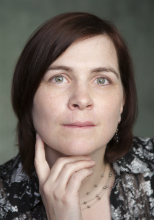Affiliation: University of Victoria

Erin Halstad McGuire is Assistant Teaching Professor with the Department of Anthropology, University of Victoria. She holds her degrees from the University of Glasgow (Ph.D. and M.Phil.), and the University of Victoria, and her areas of specialization are Viking archaology, Medieval archaeology, funerary practices, experimental archaeology, gender and life-course, and cemetery studies. Her current research projects include the mapping and recording of Victoria’s Emanu-El Cemetery, and an experimental archaeology project on Viking lamps and light technology.
The Viking Age falls at the tail end of what was once called the Dark Ages of Medieval Europe. People lived and worked in long houses made from wood, stone, and turf, with central hearths, few doors and no windows. Accompanying the long houses were smaller pit-houses, dug into the earth and serving a variety of purposes, including workshop space. The image that we have of living in Viking structures is of smoke-filled, damp spaces, crowded with people and shrouded in gloom. Among the house assemblages from across the Viking world, we find evidence of lamps, usually made from stone or ceramics and designed to burn oil. This talk discusses experiments conducted with a range of materials for wicks, fuel, and lamp forms to measure factors such as quantity of light, amount of heat and smoke produced, etc. The experiments took place in a reconstructed Viking Age pit-house in Vancouver, WA, with the aim of assessing how efficient the lamps are as a light source.
Short bibliography and/or website on lecture topic:
https://onlineacademiccommunity.uvic.ca/vikinglamps/
Halstad McGuire, E. Forthcoming: Burning the Midnight Oil: Archaeological Experiments with Viking Lamps. In N. Gonlin and A. Nowell (eds.), Archaeology of the Night. University Press of Colorado.
Saraydar, Stephen C. 2008. Replicating the Past: The Art and Science of the Archaeological Experiment. Long Grove, Illinois: Waveland Press, Inc.
The cultural imagining of the Viking Age is of an adult world. It is seen as a violent world, populated by men with swords and, for the most part, the women and children who occupy this space do so on the periphery. In archaeological research, however, Viking women were among the first to enter feminist discourse, through the work of Dommasnes (1976), and have been a major subject for discussion ever since. Children have come a little later and more sporadically, though the study of Viking Age childhood has gained momentum in recent years. This talk seeks to add to the discourse by examining the evidence for both the presence of children and the agency of children in Scandinavian Scotland. We will cover funerary practices and material culture, including toys and games from Viking contexts.
Short bibliography and/or website on lecture topic:
Graham-Campbell, James and Colleen E. Batey (1998) Vikings in Scotland: An Archaeological Survey. Edinburgh: Edinburgh University Press.
Hadley, D.M. and K. A. Hemer (2014) Medieval Childhood: Archaeological Approaches, edited by Oxbow: Oxbow Books.